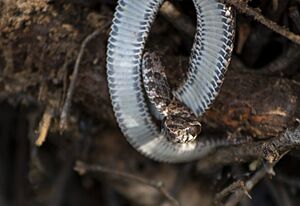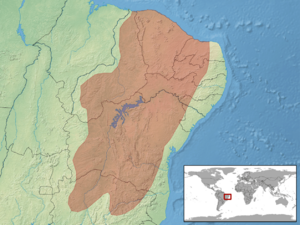Caatinga lancehead facts for kids
The Caatinga lancehead is a type of venomous snake found only in Brazil. Its scientific name is Bothrops erythromelas. People in Brazil also call it the jararaca-da-seca. This snake belongs to the Viperidae family, which includes many well-known vipers.
Quick facts for kids Bothrops erythromelas |
|
|---|---|
 |
|
| Conservation status | |
| Scientific classification | |
| Genus: |
Bothrops
|
| Species: |
erythromelas
|
 |
|
| Synonyms | |
|
|
Contents
What's in a Name?
The scientific name for this snake is erythromelas. This name comes from two Ancient Greek words. "Erythros" means "red," and "melas" means "black." These words describe the snake's colors.
Where Does It Live?
This snake lives only in Brazil. You can find it in many Brazilian states, including:
- Alagoas
- Bahia
- Ceará
- Maranhão
- Minas Gerais
- Paraíba
- Pernambuco
- Piauí
- Rio Grande do Norte
- Sergipe
The first time scientists officially found and described this snake was near Joazeiro, in the state of Bahia.
What Does It Look Like?
Caatinga lanceheads can grow to be about 54 cm (21 in) long. This includes their tail, which is about 6.5 cm (2.6 in) long. The longest ones ever found were about 85 centimeters (about 33 inches) long.
Colors and Patterns
The snake's back is usually reddish-brown. It has two rows of black or dark brown triangle shapes. These triangles might be lined up or they might be staggered. The top and sides of its head are dark brown, sometimes with even darker spots.
The snake's belly is yellowish. It has small brown speckles. Dark spots also stretch from the sides of its belly onto the first two rows of scales on its back.
Eyes and Scales
This snake has eyes that are a medium size. Its pupils, the dark center of its eyes, are shaped like a tall oval. The scales on its back are strong and have a ridge down the middle, like a keel on a boat. There are 21 rows of these scales around the middle of its body.
Behavior and Diet
The Caatinga lancehead mostly lives on the ground. It is also a nocturnal animal, which means it is active at night. However, it can sometimes climb into low bushes or plants.
If you get close to this snake, it might try to hide its head. It can be quite aggressive and might strike quickly if it feels threatened. This snake mainly eats small animals like rodents and lizards.
Its Home: The Caatinga
The common name, Caatinga lancehead, tells us where this snake lives. Its home is the Caatinga, a large ecoregion in northeastern Brazil. The Caatinga is a dry area. It has shrublands and thorn forests, which are types of dry forests with thorny plants.


